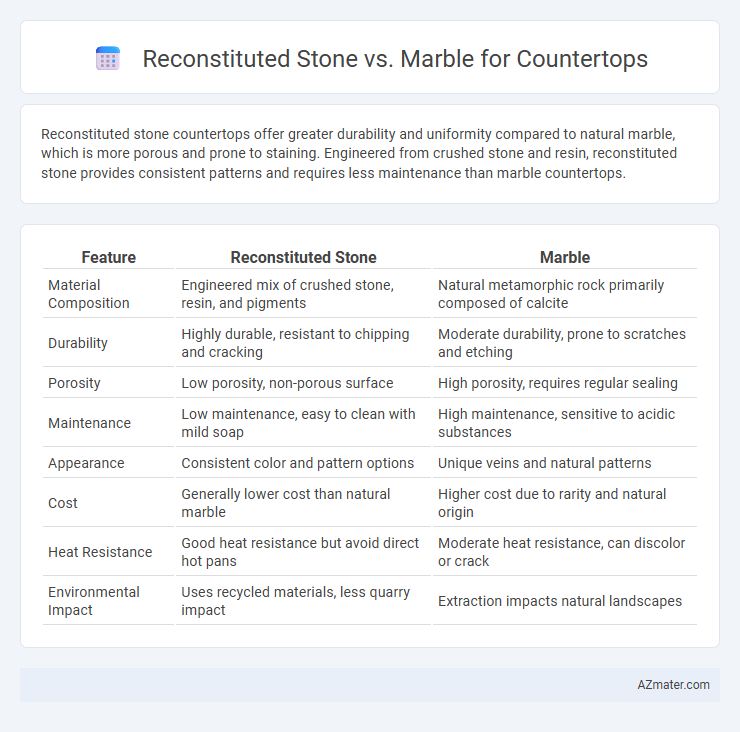Reconstituted stone countertops offer greater durability and uniformity compared to natural marble, which is more porous and prone to staining. Engineered from crushed stone and resin, reconstituted stone provides consistent patterns and requires less maintenance than marble countertops.
Table of Comparison
| Feature | Reconstituted Stone | Marble |
|---|---|---|
| Material Composition | Engineered mix of crushed stone, resin, and pigments | Natural metamorphic rock primarily composed of calcite |
| Durability | Highly durable, resistant to chipping and cracking | Moderate durability, prone to scratches and etching |
| Porosity | Low porosity, non-porous surface | High porosity, requires regular sealing |
| Maintenance | Low maintenance, easy to clean with mild soap | High maintenance, sensitive to acidic substances |
| Appearance | Consistent color and pattern options | Unique veins and natural patterns |
| Cost | Generally lower cost than natural marble | Higher cost due to rarity and natural origin |
| Heat Resistance | Good heat resistance but avoid direct hot pans | Moderate heat resistance, can discolor or crack |
| Environmental Impact | Uses recycled materials, less quarry impact | Extraction impacts natural landscapes |
Introduction to Reconstituted Stone and Marble Countertops
Reconstituted stone countertops are engineered surfaces composed of crushed natural stone bound with polymer resins, offering enhanced durability and uniform appearance. Marble countertops, made from natural metamorphic rock, provide unique veining patterns and a timeless aesthetic but require more maintenance due to their porous nature. Both materials serve distinct design preferences and functional requirements in kitchen and bathroom applications.
Composition and Manufacturing Processes
Reconstituted stone countertops are engineered from crushed natural stone mixed with resins and pigments, offering consistency and customization in color and pattern. Marble countertops are quarried from natural metamorphic rock, composed primarily of calcite, featuring unique veining and color variations formed over millions of years. The manufacturing process for reconstituted stone involves blending raw materials, molding, and curing under heat and pressure, while marble requires cutting, polishing, and sealing after extraction.
Aesthetic Differences: Looks and Color Options
Reconstituted stone offers a wider range of uniform color options and consistent patterns, ideal for modern and minimalist countertop designs. Marble exhibits unique, natural veining and rich color variations that create a luxurious and timeless aesthetic. The choice between these materials depends on whether you prefer the controlled appearance of engineered stone or the organic, one-of-a-kind look of natural marble.
Durability and Strength Comparison
Reconstituted stone countertops exhibit enhanced durability and strength due to their engineered composition of crushed natural stone mixed with resins, making them highly resistant to cracking, chipping, and heat compared to natural marble. Marble, while prized for its elegant veining, is more prone to scratching, staining, and etching from acidic substances, limiting its long-term resilience in high-traffic kitchen environments. The consistent density and non-porous nature of reconstituted stone provide superior impact resistance and maintenance ease, positioning it as a more robust choice for countertops demanding durability.
Maintenance and Cleaning Requirements
Reconstituted stone countertops offer easier maintenance and cleaning compared to marble, as they are non-porous and resist staining, reducing the need for sealing. Marble requires regular sealing and careful cleaning with pH-neutral products to prevent etching and discoloration from acidic substances. Both materials benefit from routine wiping with a soft cloth, but reconstituted stone demands less vigilant upkeep, making it ideal for high-traffic kitchen environments.
Cost Analysis: Reconstituted Stone vs Marble
Reconstituted stone countertops typically cost between $50 and $100 per square foot, offering a more budget-friendly option compared to natural marble, which ranges from $75 to $250 per square foot depending on quality and origin. Maintenance and durability also affect long-term expenses; reconstituted stone is generally more resistant to staining and requires less sealing than marble, potentially lowering upkeep costs. Overall, reconstituted stone provides a cost-effective alternative without sacrificing the aesthetic appeal of natural marble in kitchen and bathroom countertops.
Stain, Heat, and Scratch Resistance
Reconstituted stone countertops offer superior stain resistance due to their non-porous surface, making them ideal for kitchens prone to spills and stains. Marble, while heat-resistant to a degree, can be prone to etching and scratches because of its softer, natural composition. Reconstituted stone also excels in scratch resistance, providing a more durable option for high-traffic countertop areas compared to marble's susceptibility to surface damage.
Environmental Impact and Sustainability
Reconstituted stone countertops, made from natural stone fragments bonded with resins, offer a more sustainable option by utilizing recycled materials and reducing quarrying impact compared to marble, which requires extensive mining and results in significant habitat disruption. Manufacturing reconstituted stone typically consumes less energy and produces less waste, while marble extraction and processing generate higher carbon emissions and quarry spoil. Choosing reconstituted stone supports environmental conservation efforts by minimizing resource depletion and promoting circular material use in interior design.
Suitability for Different Spaces and Styles
Reconstituted stone offers versatile design options and superior durability, making it ideal for high-traffic kitchens and modern, industrial, or minimalist spaces. Marble, prized for its natural veining and classic elegance, suits traditional, luxurious, or vintage-style interiors but requires more maintenance due to its porous nature. Choosing between the two depends on balancing aesthetic preferences with functional needs, where reconstituted stone excels in resisting stains and scratches while marble enhances timeless beauty.
Final Verdict: Which Countertop Material is Better?
Reconstituted stone countertops offer enhanced durability, lower porosity, and greater resistance to stains and scratches compared to natural marble, making them ideal for busy kitchens. Marble boasts a unique, elegant veining pattern and high heat resistance but requires regular sealing and maintenance due to its susceptibility to etching and staining. For long-term performance and low upkeep, reconstituted stone is generally the better choice, while marble suits those prioritizing natural beauty despite higher care demands.

Infographic: Reconstituted stone vs Marble for Countertop
 azmater.com
azmater.com